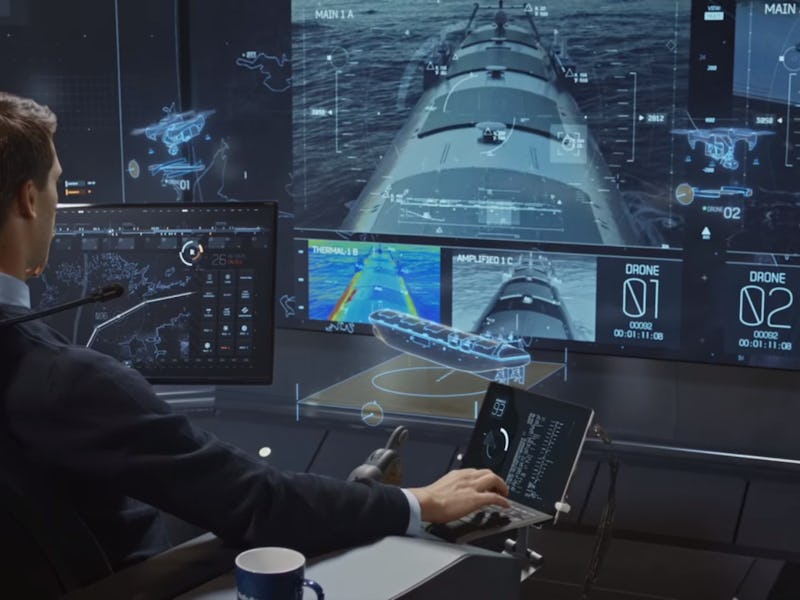Autonomous Cargo Ships Are Arriving Just in Time for the Sailor-Poor U.S.
Unmanned sea robot technology to the rescue!

When we think about future transportation systems, our minds often turn towards hovering remote-controlled drones and companies like Tesla pushing for electric and self-driving cars. But what about boats? Researchers at the Korea Advanced Institute of Science and Technology (KAIST) and Rolls Royce are developing technology they believe will make unmanned automated ships (or sea robots) a reality in the immediate future. For Americans, the tech can’t come fast enough.
In 2014, Maritime RobotX Challenge was hosted by the U.S. Office of Naval Research. KAIST’s research team, “Angry Nerds,” won second place after presenting their government funded technology for vehicle autonomy and perception capabilities. The system incorporates various sensor information, which assists in lengthy and dangerous marine operations, such as hydrographic surveys, environmental monitoring, illegal fishing control, pollution management, and search and rescue. The researchers at KAIST are also developing technology that will automate commercial ships and improve safety and efficiency.
At the same time, Rolls Royce, the British car-manufacturing and airplane engine manufacturing company, is researching how to monitor and operate ships remotely with simulations and tools for crew members.
“We’re living in an ever-changing world where unmanned and remote-controlled transportation systems will become a common feature of human life. They offer unprecedented flexibility and operational efficiency,” Iiro Lindborg, Rolls Royce’s General Manager Remote & Autonomous Operations, told Marine Log.
The system is supposed to evoke a realistic experience of what is happening out at sea. The company released an over-the-top video on Wednesday of what this land-based control centers for unmanned ships would look like. The control operator in the video pleasantly sips coffee from a high-tech chair facing a massive digital map tracking unmanned vessels. In the video, the company describes the control room as, “the nerve-center of remote-operations in the Rolls Royce OX concept, where the global wall shows a real-time overview of worldwide shipping traffic.”
The control operator can send surveillance drones and see the conditions of ships off the coast of Sweden, check diagnostics off of holograms and smart screens, and command the system through voice recognition technology. It would have seven to fourteen people monitoring various vessels. The control room research is being conducted by Rolls Royce, the VTT Technical Research Center of Finland, and the University of Tampere. Rolls Royce says that this video is the final stage of research that precedes the actual designing and construction of the project, which it hopes will roll out within the next 10 years.
These technologies couldn’t come at a better time. The head of the U.S. Maritime Administration, Paul Jaenichen, said this week that the United States could need as many as 70,000 new sailors for the nation’s maritime fleet by 2022 — adding that it’s unclear where they’ll come from. However, schools can’t supply the demand because the federal service academy, Merchant Marine Academy, and the six state maritime academies only graduate 900 per year and all of them are at full capacity. On top of the dismal number of sailors, ships are getting much older and are in need of repair and replacement — the National Defense Reserve Fleet and the Ready Reserve Fleet averaging almost 40 years old. Jaenichen said that the United States needs 40 more ships in its fleets to have a sufficient number of mariners to meet military demands.
The need for autonomous vessels also extends beyond military operations. Autonomous sea vessels can also improve safety and efficiency, and the market indicates that demands are growing in commercialized missions and scientific research. The aerospace, defense, power systems, and electronics market analyst group Forecast International expects manufacturers to produce about 29,550 marine vessels through 2024, valuing the market over the next decade at $15.4 billion.
“Sales of torpedoes will account for more than half of this market’s value, but the unmanned vehicle segments are growing rapidly,” said Larry Dickerson, Forecast International’s senior unmanned systems analyst.
Currently, the analyst group reports that the unmanned surface vessel industry is worth $6.1 billion, while the unmanned underwater vehicle industry is $1.2 billion.